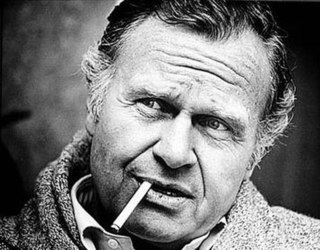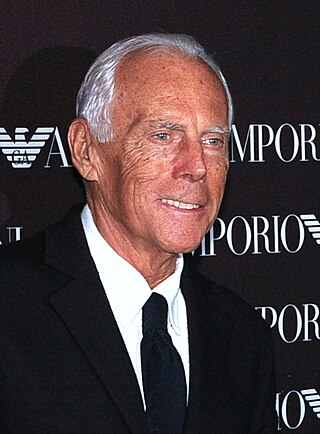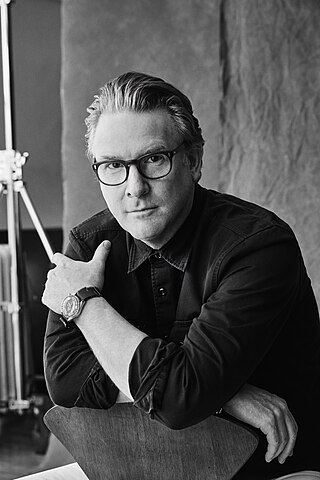
Donna Karan, also known as DK, is an American fashion designer and the creator of the Donna Karan New York and DKNY clothing labels.

William Ralph Blass was an American fashion designer. He was the recipient of many fashion awards, including seven Coty Awards and the Fashion Institute of Technology's Lifetime Achievement Award (1999).

Giorgio Armani is an Italian fashion designer. He first gained renown working for Cerruti and then for many others, including Allegri, Bagutta, and Hilton. He formed his company, Armani, in 1975, which eventually expanded into music, sport, and luxury hotels. By 2001, Armani was acclaimed as the most successful designer of Italian origin, and is credited with pioneering red-carpet fashion.

Giorgio Armani S.p.A., commonly known as Armani, is an Italian luxury fashion house founded in Milan by Giorgio Armani which designs, manufactures, distributes and retails haute couture, ready-to-wear, leather goods, shoes, accessories, and home interiors. Among others, Armani licenses its name and branding to Luxottica for eyewear and L'Oréal for fragrances and cosmetics. It is considered Italy's third-biggest fashion group behind Gucci and Prada.
Willi Donnell Smith was an American fashion designer. At the time of his death, Smith was regarded as one of the most successful African-American designers in the fashion industry. His company, WilliWear Limited, launched in 1976 and by 1986 grossed over $25 million in sales. After Smith's death, his business partner, Laurie Mallet, continued the line with various designers creating collections. Without Smith, the company floundered and due to financial problems and poor sales, WilliWear Limited ceased production in 1990. WilliWear was the first clothing company to create womenswear and menswear under the same label. The accessibility and affordability of Smith's clothing helped to democratize fashion.
Nino Cerruti was an Italian businessman and stylist. He founded his own haute couture house, Cerruti 1881, in 1967 in Paris. He managed the Italian family business Lanificio Fratelli Cerruti, which was founded in 1881 by his grandfather.
The Coty American Fashion Critics' Awards were created in 1942 by the cosmetics and perfume company Coty to promote and celebrate American fashion, and encourage design during the Second World War. In 1985, the Coty Awards were discontinued with the last presentation of the awards in September 1984; the CFDA Awards fulfill a similar role. It was casually referred to as "fashion's Oscars" because it once held great importance within the fashion industry and the award ceremonies were glitzy galas.
Anne Klein was an American fashion designer, businesswoman, as well as a founder and the namesake of Anne Klein & Company.

Joop GmbH, branded JOOP!, is a German luxury fashion house specializing in contemporary clothing and cosmetics.

Calvin Klein Inc. is an American designer fashion retail chain marketing its eponymously branded products worldwide. The company, which became famous for its designer underwear and denim lines in the 1980s, specializes in mass-market ready-to-wear clothing for all genders and age groups as well as leather products, lifestyle accessories and shoes, home furnishings, perfume/cosmetics, eyewear, jewelry and watches in the mid-price segment. Its high-end runway fashion division, which represented the top level of the various Calvin Klein sub-brands, was discontinued in 2019.

Ports is an international luxury fashion house founded by Japanese Canadian fashion designer Luke Tanabe (1920–2009) in Toronto in 1961. It specializes in luxury women's and men's ready-to-wear as well as accessories. Acquired by Chinese Canadian brothers Alfred Chan and Edward Tan in 1989, Ports expanded into the Chinese market in the early 1990s where its parent company — which traded on the Hong Kong Stock Exchange from 2003 to 2018 and has since been privatized — now operates more than 300 retail stores. Sub-brands of the fashion house include Ports (International) in China and Asia as well as Ports 1969, with subsidiaries in Milan and New York City as well as a flagship store in Paris, for global distribution.
Italy is one of the leading countries in fashion design, alongside France and the United Kingdom. Fashion has always been an important part of the country's cultural life and society, and Italians are well known for their attention to dress; la bella figura, or good appearance, retains its traditional importance.
Sal Cesarani is an American fashion designer particularly known for his tailored menswear, which has made him a triple-Coty Award winner.
Zoran Ladicorbic, known as Zoran, is an American fashion designer who launched his business in 1976. He is particularly known for extremely minimalist, understated garments following the American sportswear principle, in neutral colors and high quality natural fabrics such as silk, linen and cashmere wool. His clothes have been described as "Gap for the very rich", and as "revolutionary" due to being designed without "built-in obsolescence".

Todd Snyder is an American fashion designer based in New York City. He founded his eponymous fashion label in 2011, and has been called "the most influential menswear designer of his generation" by GQ. The brand was acquired by American Eagle Outfitters in 2015, and reports over $100 million in annual sales revenue. Todd Snyder is also the Creative Director of American heritage brand Woolrich's Black Label Collection.
Adolfo Faustino Sardiña, professionally known as Adolfo, was a Cuban-born American fashion designer who started out as a milliner in the 1950s. While chief designer for the wholesale milliners Emme, he won the Coty Award and the Neiman Marcus Fashion Award. In 1963 he set up his own salon in New York, firstly as a milliner, and then focusing on clothing. He retired from fashion design in 1993.
Sydney Wragge (1908–1978) was an American fashion designer active during the 1940s, 1950s and 1960s. Working as B.H. Wragge, he was particularly renowned for his American sportswear, with the historian Caroline Rennolds Milbank declaring him the leader in mix-and-match separates and interchangeable wardrobe design.

Adrienne Steckling-Coen (1934-2006), known as Adri, was an American fashion designer whose label, Adri, was particularly successful in the 1970s-1980s.

Charles Suppon (1949-1989) was an American fashion designer.
William "Bill" Atkinson (1916-1995) was an American architect and fashion designer working in the American sportswear style.










